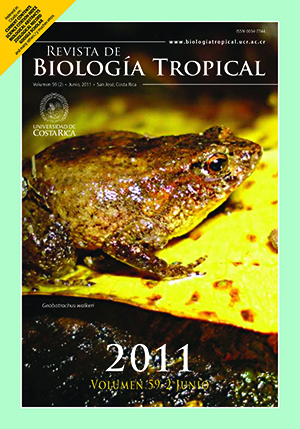Abstract
San Pedro River’s wetlands sustain trophic nets in the fluvial system, due to the high habitat availability, and space and temporal variations. In order to describe the relationship between environmental parameters and ichthyofauna, this study evaluated fish assemblages composition, distribution, abundance, density, biomass, richness species, diversity and equitability in the wetlands. Sampling considered three different sites and climatic seasons (dry, rainy and cold fronts). The physical and chemical parameters considered were dissolved oxygen, temperature, pH, water transparency and the depth. Fishes were caught with a shrimp net, after six minutes towings and were identi-fied afterwards. A total of 1 049 organisms of 25 fish species were caught, two of which were exotic species: Oreochromis niloticus and Parachromis managuense. A total of 23 species were found at site I (with the highest density 0.23ind./m2), 17 at site II (0.23ind./m2) and 14 at site III (0.12ind./m2). The dry season had the highest species number with 21 species, followed by the rainy season with 17 species, and the cold season with five species. Similarly, the highest biomass (8.30g/m2) was found in dry season, followed by the rainy (2.16g/m2) and the cold seasons (0.03g/m2). Considering seasons, highest density was found during the dry (0.436ind./m2), followed by the rainy (0.213ind./m2) and the cold (0.023ind./m2) seasons. The dominant density species dur-ing the study period, according to the quadrants graphic of Olmstead-Tukey were: Petenia splendida, Vieja heterospila, Vieja synspila, Dorosoma petenense and Astyanax aeneus. There were significant differences in the species richness among sites. Temperature, depth and transparency showed differences among the seasons. The canonical correspondence analysis indicated that fish distribution was governed by environmental parameters during all seasons. In terms of fish abundance and composition, environmental parameters play an important role showing spatial and temporal differences in the ecosystem, this could be explained with the fact that most of young fishes have a movement behavior to the wetlands, searching refuge and feed during the dry season. Considering the diversity indexes variation, it may be concluded that San Pedro River’s wetlands correspond to a system where the ichthyofauna composition fluctuates spatial and seasonally.
##plugins.facebook.comentarios##

This work is licensed under a Creative Commons Attribution 4.0 International License.
Copyright (c) 2011 Revista de Biología Tropical






